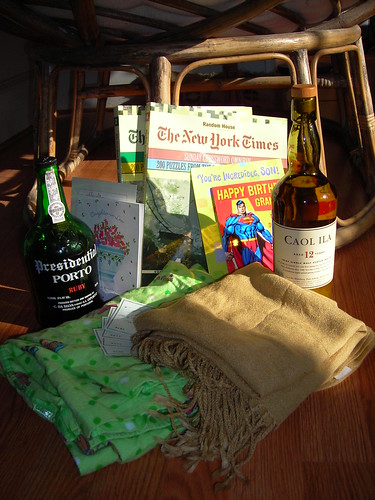And my procrastinating little self has a ton of labwork, a meeting, and a postal trip (perhaps figurative, but certainly literal) to do yet today. So, here's a less deep topic for this fine Monday morning.
Also, birthday loot:

Me to Mr. S: Good Scotch, shoes (not pictured on account o' he was wearing them).
Mr. S to me: 400 crossword puzzles.
Me to self: Port, silly pajamas.
Sister to me: scarf.
Sci-in-Law parental and grandparental units to us: Cash and cards. And a Superman paper airplane.
Mother to us: Hot water urn that doesn't leak on the cord. Not yet arrived on account o' neither of us plans in advance.
***
Irie asks: "My husband was in the Navy and told me that they used Kool-Aid to clean brass. How does that work?"
I think the first question is why on earth does the Navy use Kool-Aid? If there are any readers out there who know, please tell me; I'm fascinated.
 Brass is an alloy of copper and zinc. Like most metals, it tarnishes: the metal combines with oxygen and/or water to form oxides, and it gets less shiny, or green, or brownish. If it's been touched, it will also accumulate a film of oil and minerals and dirt from the skin, which minerals etc. may hasten oxidation. Many metal oxides are insoluble or sparingly soluble in water. For example, if you put a tarnished penny in water, nothing happens: the tarnish doesn't dissolve off.
Brass is an alloy of copper and zinc. Like most metals, it tarnishes: the metal combines with oxygen and/or water to form oxides, and it gets less shiny, or green, or brownish. If it's been touched, it will also accumulate a film of oil and minerals and dirt from the skin, which minerals etc. may hasten oxidation. Many metal oxides are insoluble or sparingly soluble in water. For example, if you put a tarnished penny in water, nothing happens: the tarnish doesn't dissolve off.There are at least two easy at-home ways to shine metals: with a mild abrasive, or with acid. Abrasives such as baking soda or cleaning powders will simply rub off the layer of oxide, leaving the shiny metal visible beneath. So you can shine a penny with Comet, if you want. Or, if you're obsessive like me, you can shine your pots and pans with a baking soda paste.
The other popular way to clean pennies is to stick them in vinegar. Why? Because the acid reacts with the metal oxide and solubilizes it (by exchanging the hydroxide for the acid's counter-ion: Fe(OH)3 + 3H(CH3COOH) --> Fe(CH3COOH)3 + 3H2O, for example). This is also why you can clean pennies in soda (pop for you Yankees): it's acidic.



So why does Kool-Aid clean brass? As a powder, it's probably abrasive just like baking soda; as a liquid, it's quite acidic. (Irie notes that the Navy used it in the liquid form.) The ingredients, other than colors and flavors, are: citric acid, salt, cornstarch, calcium phosphate, and ascorbic acid. Tang also contains citric acid, which is why it can be used to clean various things including commodes. And in fact, non-Navy people do clean stuff with Kool-Aid. Personally, I go for vinegar. Or Comet.
Bottom line: The acid in Kool-Aid solubilizes the oxides that tarnish brass.
Fun random fact: You can mix Kool-Aid powder into your Rice Krispy treats to make tropical-punch-flavored red marshmallowy crunchy snacks. All together now: ewwww.